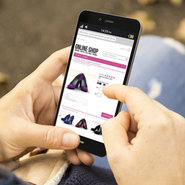By Alex Samuely
Retailers are missing out on significant revenue opportunities by failing to personalize consumers’ shopping experiences, thanks to the lack of adaptive pages, product recommendations and search functionalities on their mobile sites, according to a Retail Systems Research report.
In its “Personalization Across Digital Channels” report, sponsored by predictive analytics platform Reflektion, Retail Systems Research highlights the major faux paus that brands commit when it comes to mobile commerce. As consumers’ expectations for retailers’ digital offerings grow higher, marketers must deliver optimized experiences, including saved search histories, suggestions on previous purchases and responsive pages tailored to each device.
“Unfortunately, as poor as the implementations have been for personalization for desktops, the implementations for mobile/smartphones are even worse,” said Kurt Heinemann, chief marketing officer at Reflektion, San Mateo, CA. “The unfortunate part of this is that solid personalization can have an even bigger impact on mobile than it can on desktops.
“Conversion rates are already challenged on the limited real estate available on smartphones (basically by one-third of desktop rates). Personalization makes it much easier for shoppers to find what they are looking for in this mobile world, which is half the battle for visitors.”
Pointing to personalization
It is no secret that consumers experiencing difficulties navigating a retailer’s mobile site during the browsing or checkout process are likely to give up if their frustrations peak, which may prompt them to flock to a competitor’s inventory instead.
The presence of more loyalty and rewards platforms also means that brands have access to additional CRM data that can be leveraged to personalize the experience and drive revenue. However, many retailers are failing on this front, as evidenced by Retail Systems Research’s evaluation of 100 top Web-based marketers’ sites.
The brands’ personalization tactics were deemed to be rudimentary at best, according to the report. Fifty-two percent of retailers do not optimize digital content for the device with which consumers choose to shop, proving they are not offering context-driven channels across tablet, mobile and desktop sites.

Nordstrom's mobile site does offer complementary product suggestions
Thirty-one percent did not provide any item recommendations on their mobile sites, as opposed to 26 percent that did offer suggestions remotely relevant to the item being viewed. This may put a stopper on impulse purchases made on smartphones, as shoppers are frequently swayed to add more products into their carts if they are recommended specifically for their tastes, or complement another desired piece.
A February report from Contact Solutions revealed that consumers are increasingly looking to recommendations and assistance options within mobile apps during the shopping process, suggesting that merchants should not overlook the initial buying experience in their efforts to streamline checkout (see story).
Bumping up mobile search
Retailers’ mobile sites should also place a bigger focus on retaining previous search histories, another tool which is able to help personalize suggested products and improve browsing experiences. The report revealed that 83 percent of mobile sites did not recall past search histories.
“Other than not implementing personalization, the biggest faux pas is not creating a smartphone-specific checkout experience,” Mr. Heinemann said. “The standard desktop checkout is a nightmare to work through on a smartphone.
“It fatigues many users to just leave their basket hanging,” he said. “There are a number of things smartphone checkout can leverage that make the experience incredibly easy, such as context aware keyboards that limit the need to go between alpha and numeric, auto-complete addresses leveraging the Google Map API, making sure to use mobile wallet options (PayPal, Google Wallet, etc.) wherever possible and just simply eliminating any truly unnecessary questions/data fields in the checkout experience.”

Victoria's Secret prompts mobile site visitors to sign in to unlock their preferences
To ensure that shopping is as optimized as possible for mobile devices, retailers should focus on context-driven home pages, similar and adjacent item recommendations, adaptive sites and segmented smart search.
Home pages must offer prioritized content to help guide shoppers, which may include mobile-specific promotions, imagery and features. Saved search on smartphones is also a must-have strategy, as some users may tire of typing in the same key words in the search bar.
Instead, brands should save these words so that they visibly pop up when a customer begins typing.
Retail Systems Research also invites retailers to sit down and personally shop their own sites to weed out any pain points and customize the experience for each digital shopper.
“Mobile users have very limited time and patience in an environment that is full of distractions,” Mr. Heinemann said. “While you can’t eliminate those distractions, you can make sure to reduce the time required to checkout in order to increase the odds that you can fit in between those distractions.”
Final Take
Alex Samuely, staff writer on Mobile Commerce Daily, New York
{"ct":"OKxKe6m\/rn+7RSIduL8g3fmkPTirsroDBHxOrWssA4YiBOudoKx5iD9RcEqIJNFEDl6OW+yCGaGOSn0EviOOwiGNopsOCQSD1wMdR2x1hY3ZhZZ8Z7XrbaJDYnTvQ4K9F3acub3+VfleTOQ\/j\/0ICUZZo8R5QlHVJ0kwZdQ3xp9oNsRgH4wr7pgoaDEhjOqjSw0RsdNfXulPetLXjunqdHQB9Kk6Zo5xS9ZFv2KM\/cK+6sHHuTzhvfq+gc9qzMxicXb8AwAidY9jEvYR7Zl3NaXRj5EXx48CChURDCIK8bH\/nMJpBTKksMtOnl0MFMwjeLWGmZsCpPuKsSSZWyc7h4VWzdJ07ym8cDPS+lqHSxC65ro0QIQQIHxgT1vUF9lLPo2qD1jz976lsaYNjtK4obe0acLEk4pbrT0pYP49rKwrNay6VaEo0fD9ZaZM\/AQ+WuPvpmhLul8tWAypHqt7mO6+rMgFQWle0woDKtqkUdjg2xlNvMAkXfLnoVzz8AUcsUz6wJukABtxvYkSJpPQHSaVV+TgSjSzzw9x\/fD6WJGO1IOWaEpbXSBQ3OYB69BgLtrba9XeUfPXqC3P\/WV5dNPJQaOqUocL4mx++79JeS5xRYEJyNL45SzfacC8R+1PUgR8aFfxsmdObzMQmW\/dLfmKMiV\/lRMbYPXHLWWDVHI30DrAc2D1e+BKq42I5nAfqe2KvbP3QMq257SmdOSHlkUxERVgmwzpy8Rhq+pdpU3SFMpkAP+7TBaUPNp72hsEBZRoVXuJEOPDSm3vgvHKhoJlY+rckP92eDqPVsmGqFZ9UXhIr8pVAAwFI+3ai5iA+HmvKfyZdzbQNuj3mje+SwRigHrRjf6Zn8u2bGw9QenL4u\/w+SIJE1M9wM+4SybOBN9Qz6UAZYdif3agql6uAK6kHnQZ8tKj+Wm\/iXFyoMuRf\/8MKXFFIsMWJnuCPlasPlvyoUw3WJjAx5lVcTTb2B5cb7PRkiViCbQ9yvBeCA7jOuX+8Ksr1T9T0rfJhD7BiKdNeY+s\/Gxc8ISVzi7fzpyK+T7aVqkmsnsaAoueh3EjQXZTNIw9fTYb61fXT9TAwOYjRgU3x7c8vNHUCjzW9zPjvwx8Jfowm4LQXuO5jZj1fzoCamp3LWgVXjsPcdXq+zteZ1T0gKaZvRQLWhphp3szfEXPJl6OZK2oG2BSkERl48LV1NLLHHmo\/zc856PDbz+EU1kFeJGVAW\/ToviAfKJdSUcofXD+fn3nHADu0fhQGX6U1qOA3RFQCdNashxeH1QebrHw4mQ62S5Oahijlpwf8pvRlzCHy\/gEH3Y1r+eWu20txfygwkOjgh61dM24IxJrjwt6kYDMODTP+yBg39VDKcMVX08Vb\/BWwSFz6I+StbWm3TDIfmTVy3MeTIptReGouNFBSJMkCkhzl2pNpyVGFh6w2HQGinM2ADF0VA8WoxEHm9n4T9iSptP75ddORHljK9UNmDKBR8mctpE9V0qh4CwfKGbglaNTk7H4hxzYdqn1TsU0EvaTAHkt9aE\/E\/koSXQEDYq+wiEMsgPOl6kbyjDXkHs9jhiyHxyR7hda9VcWMjqwnlLghiV4OFuhN9Bj9V\/oV+iKWZwaWquNhvGv+jQaGfOwenPo6BXSsqTS+XjBqQeHrUw12YB7BNNKWp+1WgnAeiDl0q12atWQCCNLORXuqw33fkeabeJGDbZMJO0pBFN80taNuKT9Z4uh9xp9VFCZRuxZ9TgXdPRWOQ3RH\/d7ObS6li9qLTEkh4KtKzqtML3YhAPuhEGsQfUMng1Nl7OTa8pQrUOEww7JC8+H++wDihyudus8SPCNk0OrY3DqEFTVK8tU83AyigmVTCnVXHhIKiRGrOjnGaKWX1T9GZmF0AK4y99Ts2PQO9IlRBa2zaVybfUaBAVVBxSupuqATXKFyn5fTC7I19nbjIjnN0WZ\/K961TytwzvGC2E\/9DljpMR0P6Q0Mi99n6TdXhyRcyrwDoigX4vjRJNNOUjaYaZ0wlYzMQLju4R+ev2mRky0NeXm9h0YnYw0UpNNPogmattzLGFIkkQdEH6hu9qHUMRGYhfYPnqyuDxHvIH081rkUfOgm15AcmF2fIZB9Eaaey4uDwfaRLQo0genNTR86MInm9pBa30Eb9gXL7QNd0YbkePuvXtW99OQUKCNjzgnOm\/e6z6B\/3FL83dzUyOKTBYuWPCs0AejYVPN5e+iWRGR2R\/7buRvwD+iAxKxhEfJr3I6Azi+H8UX9rxPng8opX4CIJnw50IkAMHYdeGTj0IFpAvbkb7dDIH8iNQ+CxI2O19+jvqqDHuVDtdAhHXnhSCBSpA00wTYWh7KGWj9+q57j0GlD9Uqe6LBpbqTL6q1mhtJyZ8EKyx0UIdmbvUr+UbwvxZxozwF2V0XFGkYg7QO9limiwOUZS0pNWqzNmF59ae2WDrOsMqadhCF28KsMo7mtAC7Oi6KzT4of+NPfCInj7NRwA6RRv7wEcZTeznS86HD0zoNcNTukFedKxZrh1kI\/A4Dkv1bR5o66DUO+tPTp6T+1Twoh0\/Ca+5jxzuoRHCdVZ10gwj0CAhjvfIqH7cJjux6AoP7xi4jg\/fNafil64uc2m1L0fxoYsgJ4CyEXDOv2jOKuqvhrIW8pg\/wUR4twuraPtKBpt1iK+JkBH\/2aO5Zhz3Z3Am+Z2TgEHVz8tMzqMEaAn6W7qkZSZVklaz65s+y0i0IoK+Pb\/jcz91bbIXSFIU43JrVWOWDDr7Du6kbtVrAFtpnS6QqBhXjEBqrLgNjPyhey1m49gJafFSOWXCqkCB8A3+5FQ1jhTE1GKtZSrek4v7zD8Pn4amWpuDnmNx4SyTnir8Co+yRilQI2wzx83N233oCz2pM0X3J1O56zmxCVTN\/OPK8UJPdRVqCAzs3lRnKCyTZnmkgf3PgqrJmduebqhP8NyWlnhFoxxUrv\/Bsa9lRj7jffZqXLAsRvF1LOOpQm21I3ZsDPofjWBTjbq1Lrme\/h3iDzAtjrqUCwYCDBOU9XFlwGayk01PypRjJ0cgaeoVgleQhz0G2ekaQPPJQQUT9VZhT3easJRIFJ8Jj8XXh9eNGpN8B\/kqMaJZ4WM3l72lINNd7DlMIO5q306JxqJfeM8ZKnlW16B2lWF6yn1MM9KQ53\/nhbS3AkritUbwgilTEyEgRxbxR+vqyGNFxTLogzScyadNvnenTn\/pjo0oe6kupXWKZDvMyb3uDhX76hoxLFIAKkGgD8w\/CUA8IwwFpwVQETw4TUw8pmkVzse\/bUtsups1iQHrEux7hkVusmXD0mM4iva24O3Cx1Mg2eptN\/VXukBq\/CNZx1GvyyxZuDojdxDKp2dna\/USm6bz6ECZsuYELw7zbYdbTKwtIHKSKDNnRfoad0N8VbgUc0wQPlwTcK4HfgwGpjt2\/TcmjH6gqzrXmfQwLnikAY5rizLOpV7YO7A0uiBGG3USq3LoskUd+nKZIcpIwYoVFjNJJBPRvvlRC7mt9QEaF7gC1lTZtsnz7ZYFhPvvAPnm2T3BK1F9H2lg30TcKYvJ1o+prSbY+VCZxpXVkIKdPhOXQfbPlWR+Gi\/97t6eHRbvx\/CL8gB1e19LaLdVAiLjJRwAQ6RDlYhcys9dDS6fdE5AnLM5bo7Qvu7PADS0GK6MgWFFB5S6jfbIkJhdCONKOp5We69owS04VIHQuW9EGX4NZkBO5i4YXW1nEi9DanbReZUhe\/ndv+yXMP2C0dZuXVfy7mNxc39NmBgq6ZHZLCNrYVPNJ8W8oCrVDGogaMN91\/Pi\/autIBzNIwKh5yzTeBwJpneK\/VK5de4+kjY5f7aALmQyuReEKRMgqfmxiCJhbVUi54AJsvmn90cTJQP2oWKBSm+59Y91LHRbkHaMM5hRpy0I\/5X6TXYpPQTPtb2Nx3oGi8Jlvy7SRo5VOv2ZQPqja4UUZJawWMqE\/cbOSlWRvH5FnyRxJpjmuvyzi3Jw+bLkKkLzsYi1kundkUDr8nmpeKgJSukRNoAhbJiqlSEMrLOcdfp6UI778pAcEBlrwVZWlyZYMyUt2ze4MdiikboKm6eRdi7c8cIrUg1BqjjqTTyqcsQ2CYPCVp4RmBCR3p4v6LRQxng2CCjDQ4l13pncYhrpjaj4x127Xbw+9MbBDctvExIohOaDRiIDlHALCdKGwaHF9oGhq7RxXVqVgLs+KSCcGTbWAEqDC9i2su+DoFaSmJP06c7WfRy8iGrLckZciwCB4CHuNhCgK4cBS9xFZIJLw8SfznF3nX8perrq2QTujaaS4fHA0Eb6ClTr4sk4yj15vA4zKKe74xUmqUQCm0G3Crw5RfoW73ru2X\/cGc8SrzVjTI0th9GdV6bos2PgE3ZCkFwrpUBFznCv+2VgkDI0+vXdKtzrXE4tt0leO96QukW03yI6anUzZ2wgNw9rNaMI+HpmNuVNW86XHATnRhYWn78UOzlEfLjpegZVhzqCg9cZ4C6uz3DUbn4l3D19XXM2i5PbKf\/ZCRhtQE\/v5tjv\/ev1FRnHniT6hmFAnhlyT98++OKbThM8p4\/BQs2g06tOJa4drRWTBmgMk+BH5y4CfxBR\/XhYRJ+0I4m0GOyO0xlMvYV5k\/6+WkzDHENZFi\/Qg5zcMm\/gX0Ua7Z9WtrFfO0tEDPfbZW7CcWWvfFdRWeEDz8zz8qlXuSJQjt+1dlLzIsQdNRn++UUBF8AWlVkgUf91MJ9MfWy44iodgKs9nzCEVjcd\/A6jNWWscqoY8gRPHepVMneG9J550RKbV7aOgjaZs2bux35ctwSGCKJWmXoYQwGxX3nfXJz4LM5MFSs8qc27UGyjEtwLyVNa5M19dXLQi4Xmaquc7EAMvcP8ZvzhXiaWhfDKIHP8eRF0Ml\/HgLMHGD4sY5zSejuA046Am0NQR\/tR+vLhYDVQ6DoEnsvg+Y1nf5cIuDyTbbKyWXYZWlBKS8s06ai83Mh1TLb+BJ9c8xuffVq5apdp6fHVISDRSc9I1is\/kTVGsnfUJ76U+5UhgWBOPM8SB61wE7EPi5MIF35uorZmC+ziuQ\/w3FrjwIYvtgtUldkx\/NTumdE7MrzlMRBQd8FpV6yAUvdkxq4TFmhA\/fpQdpelaJ3Rg4GgQk2bw4t1Eg2fQk6BdQVUUn3PcihBDpHI9FXz6TMR2lbtc3kN0fKheuz+KDob+JKcV94HIcc1zXCqzAFwwgShP8VPT5jLe0SoH87uO5kQa9BJV0r2SFqoU4kV2yPH6Bl4wQ5MjW55Uha9fx1HiEZGqsWPRb4p2PZtAfWPAco1efoGDpY0x5CUC+3dpMX\/STQXwvFlkD68AWSBDMHff3vHCcrOdeZXjbXJUWywXN9Eo+HNvKYAJefeNF1cpl\/4GX3VBhTPTX9AjwwQ8Id25VU0UhjP5UVFqIdgCeT9JPKezbIg72lhypj09VCasCuQ\/Sb9crCxublV\/uL1TI3iO1jWyrfrcoJtAtPAw7lCHfUXrVy3qSGpil3CHEnjkXq7xfZWvv\/4netty7Fr12TV8prjglnjP9tFxcID+tdOcRa5IR3hFJHjcl9MHdwbdXntPTh8+veMeScmn5HClT4zDJEZQN1+mpCK69rSTO0kkptLitbPUxGvJR7oAEsIaFV7MSwzbBlsgsVepL8kFI5Yj57Xqmt7g+CpfzvOd6MlfY+iFqFFjSVxGUqjt\/YPLWIru5wKUTWXKfBglroyoDso9AiRLfHQVt+e3xr+gyIOxeAs+cK4ugpgWKySoL7GGPZD3O\/KhQv1XiNIHBZLYlcPjQonDzwxztJDu+J2C77vsY\/+MzqbUgzHyaP1nt7qYyWfdSzG0bhU8chfAybD50ouSHuYF\/vvZjoxXaybZjn8D0MuDR+eAPsaoQV4tdbfungTrNwqzKx5Ld1sqEBE184x4cou9eD4PbCkAuMKXQsEQk3gydhUo2krG7jNcn1e35fMvfjZ0wtqfCmDCE0ivogZ4B1PnRZq7UnItvKIRI0I+RNnCFQIjpA7CFKi2+mf5OdpfiubHLgCoKUfEvvPtQAjKJ4Cs\/A1mKKzd4KwyA511Emz+lFbTT1sX8UliZ18RrAT31y2laFaB1+r7wd04ZbsgQNqwY2xjOHF2c4slcRyGocDG9tKVRsfuq\/vmZ6p2dfjinImqkCU+SYEXgXrbhDpAULU7kUeFk5+NAb9k7nuUYogQC4BvVRXVYwH83lFL+MPHAPNO2l+ty1OVRiiwOkbLtBnFbT6TKsq5N9MOensztWHTKrVy0kJKNPhq7mkHBY9E2UXGctoDskxDCNuER9pRqQVaamLwulogdlCQirek9HcRkTYa2n90u2sGHcE7VkHJ8Pmbp+byaqZSEqAmOFbA20dDvuTT97xMSrPI77PryK7LPiZ2Ra1d6Uq5b1cMLdksejSmR04uVNII4Ds0qpSCbqhhvOmMOlcGCZHKliCZvWnfgW5j3nTFvGf17t+6AAj\/wYs4H5HX8NHAI21DvEejbt+BeonSkM1BaoL7jUazPExYLvnhzeAyONECf71wCzngUoXn7tAw7PqTFLIO9A4K9bR6QhTbYabWwyKoZo6qUpziaPdS0Nhn0zRHOz3mm+gQkz3GX700OSQNNMOqjoz7Mlv8mX4aYB6IdXaH7rrRFKE5guhNA40N7CnkD00YqoUrt+fC4U3kCcoAyHTrLjnVz3pP\/6V2ew3PbsGdZAKgNwonqPckjnNkFWhS\/+JZRHmCH6ZDbQ2OUTSw1THfrqaKBjjIZisdJeZ6IWNv5yrUZTG3jBTnyOsh2NV5FPGX5dr6iu6zsVmi1LyepRfm2FjdNWbHwYAauxYRWhMDzdAJBCtUDIgL4D2gKZ7YMS9eF9B3tQxdRb6jU1W\/zzpw3nxT\/uQ2Z7Bjl8OFeLF9c66RfXE\/9aheN9CUCsa2N8NNet4eV8mbPMZRas9W0Elp9JkXP98teNUgAvt7+Rds1rkVDzkldhKN00z6Z7UaJY+l67K9B0xuBTmUADTSaAvhg6YL6qjVTo7zjP51yxMNhG9XX1qGRkUNhkMC8XUr2JdnZiB4h6L7BrGdeOl1qv1Wa6yp+uO0FAtbXoUzV\/3afJJz2JIK74+4DxSRmSEix9CvjA1N+gGzjigH2nXODUfa5fqzb0tnhaJHmmAcnLjcpkEpn996fjR6Ig6W9GYoK8D4HJA7iUC1LNi9uvQbRhfx4f6gdonmDYbpv3CeKfubSD\/GgACq7fqy2MksmvzfJa7Qhfp46P7lZLqKrZuQY8\/\/oAEyPl9a9YfziixXA58o9l\/YMJGI0ubzvJYLNCtnDM7qFZgtS8HyPZQtcTTA72M+WBEQzjiDmsoN959jWdgXnUn2GPOEhUFeEkbWnj4Yig5JkRPLlhfM8WQblOZi\/gvVX6mVDhOFLrzvLfQ8jBey+sIQBYuxJinDp+sDZXH8QEu2Gd1iT43qHMxEE56LznwxOh12slVO1lUXDzG2O3BTNfwzS5i2CkP\/WQOTXrHQAsM63DwY6Z7JPIQTbwKWWgOJRhcBib5GlUnWC4S57+RaoTLi9AH6qFORtR1LrUpawPANcSXxdu60CLO8YC2g8nl867fFmkoYP+mz+TpdT9\/XKAhmPo0zN9s+R+AhEM9QT5OdXtg92dGgaRyu85LOMpYrBSuOMKjhBTo47P6xjiagbWhcJpfpbsHgVCheTGmcg7CPKfHLxgoQlUueuECeUetWpli8IGLKjc2Ndv8r8pmv1FIzFFhGa1z0Hp4OwcKiOEwqp\/GWoDzz+2pWjHGOfHu5aSAbj38BytV3COR0oXUQmhSjH3+LqdBMqGyIfTJ8mwPtfsqvjatnTkGaaayaA7aOkX12CVJB+CY++H5SQjNx779eu1C4uNmRihySGk4B9btdhO350C3cu5dbpoHxHe4ZYjW1Mrue56dt7jdyuYpNPeaunC9zNfttVLOuXwLA50CZ1RveWCX+toBqY3kyzQPpCLBNDfmvHnXdW+0ivHdk59ZCSkIDteSkvPQXiI3Shaog4Z2uYzJUm8FHx4RvUX14v3BaL4\/XUJqFO4\/7dSZsYcYBO\/o+t1\/nG4HcZlUmU8zI\/xuMLJ3mAXLP+8czqkGf96dXL8g932YTh57oqz6HmrE9aeV8Z\/fmgF2ZCXwRjZjYANs8KO0eIuP+Xf8TFpH689HZw8Oz5+bcA5DZm7al1XfjQVWFFKVVtfvdGtNeAW82oCp1IYnywQi9tQ4AhVTlrq5eMdBZodL3B331M2CLaaqe\/DelFi0paW7SlBBcWwWy1yq7xKeiyTx0la4FXFJ5CAMgXmrUP1aua4PQodqinJ3PD7nA7O2UMaGNocvvT7QhWqrSmCHcgAzAO1gJHIVRsHSQ5VVZKT1zGFQju\/TobpXLChHbe4yW9nsfYi+STGGnNZ1D+puUOw2IH\/DrIjU7JE+U2fzQZkhTKqS\/hV8hLWm5Ny50C89orBfvaEYg+iQbbKo7mr2l7xBBXcy8G6Krl0SaLyaKtz4t3z3WYLv9xjaI7UXqqNwSNsrzjr5E3xrTdfPKLfQkcMQfICnWJbYJS3vbHDwwiUkMA0HEjOeeVmiGuEzm3cQsaNF5utAjj2v3rCsKyvLw2VdUZ0Vse7zjqhfWyvXJy2Z61GxCS1YZt27HyJnegBs8dAm432X0FDPqc6Xbdvdtoodpa+eP4tbU3a5khUB1+VwYjLhCWYvCAxADQhtbTUEGvybeY7NJ2Tdksj5C3PoLb9gEuYdxArvF8axe+ekoihEopu+ojI12BXX3TIv4skMOJDTz\/2rWHFmzrLZxqQtcyH0NfNaN0K8Sng8ndCLWYjRxs3oZSfji7DhXoOiq6wvGhoBVdaEAhXF9a2FVRk+P+E9LlXx1W7irNAQlwM4XG+EqInbdB4KJGCFHS+NnhvPd11TMF7uALjhGCqctZudxVwAMYY2NvYT6uiIHalZBwbyUZLS22+vJCQmCoAoYbu7S62pOgYQk01HWS9lY21G7\/sfWxG62v31kudYakX8+Ox0EWg9JApt5Iun85XBnG9C9Gd614bhA9O9virpW5d3HexGamK3xhJig12Lc4BSi+BKrFyTaJJMPJd0X06ncKI0cvL37oYYv0\/kszXS7WkW3","iv":"8bf98632b695678b93402ff3e71848c5","s":"12fd71ccbf37a201"}

 Retailers must ramp up personalization for smartphone shoppers
Retailers must ramp up personalization for smartphone shoppers